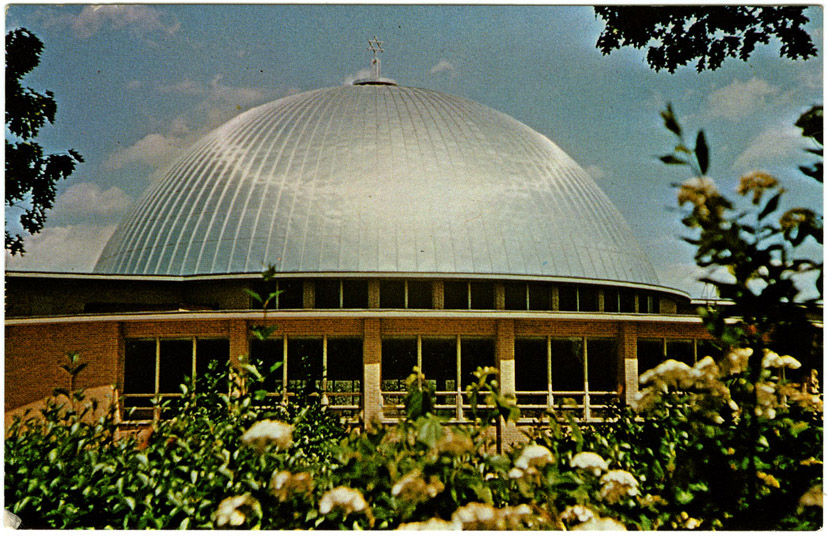10.8 Baltimore, Maryland
Har Sinai Congregation, 6300 Park Heights Avenue
Meyer and Ayers (Baltimore), architects, 1959
Henry McGrew Printing, Kansas City, Missouri, publisher; no date; also on back, “Photo © by Milton Stark”
The postcard shows the dome of the fourth home of Baltimore’s historic Har Sinai (Mount Sinai) Congregation, which was founded in 1842 as a Reform congregation, one of the first in the country. The new congregation held its first prayer services at the apartment of Moses Hutzler on Exeter Street and Eastern Avenue, above a ground-floor store. The dedication of a Romanesque-style purpose-built temple on High Street in 1849 (designed by Niernee & Neilson) announced to the city the permanence of the growing congregation.1
In 1855, Har Sinai’s first rabbi brought Rabbi David Einhorn to America from Bavaria. Einhorn quickly became a leader of the American Reform Movement and created his own siddur (prayer book), a forerunner of the movement’s Union Prayer Book. Einhorn resolutely opposed slavery and during the Civil War he and many congregants took refuge in Pennsylvania.
In the 1890s, Baltimore’s Jewish community and its synagogues began moving north from East Baltimore. Har Sinai’s second purpose-built sanctuary was dedicated on September 28, 1894. The building, which later became home to the Cornerstone Baptist Church, was destroyed by fire in 1969. Nearby synagogues Baltimore Hebrew (1901 Madison Avenue) and Oheb Shalom (1307 Eutaw Place), also constructed in that period, are still standing.
Har Sinai led the movement of Jewish congregations away from central Baltimore to the suburbs in 1938 when it purchased a 17-acre property in the northwestern neighborhood of Park Heights from the Maryland Country Club. This trend out of the city would be continued by other congregations after World War II. In 1953, after war-era delays, Har Sinai itself undertook a new building program, spearheaded by Rabbi Abraham Shusterman’s $1-million–fundraising campaign.
Groundbreaking took place in September 1957, and the new synagogue was first used in 1959. The building was strongly influenced by the Park Synagogue in Cleveland, Ohio, designed a few years earlier by famed architect Eric Mendelsohn, especially in its use of a low unadorned hemispherical dome over the sanctuary space. The new Har Sinai had seating for 600, which could be expanded by opening a door to the social hall to accommodate 2,200 for High Holy Days services. In 1971, the congregation added a new religious school wing and education building to the complex.
In 1988, reflecting another outward migration of the Jewish community, the congregation created a new campus in Owings Mill, where a satellite Hebrew school was established. Then in 1995, the congregation sold the entire Park Heights Avenue property to the Orthodox Jewish Maimonides Academy (which closed in 2009) and moved completely to Owings Mill where, in 2002, a new 60,000-square-foot (5,600 square meter) building was erected.
The congregation struggled, however, with decreased membership and resources, and in September 2019, the historic Har Sinai Congregation merged with another historic Baltimore congregation—Oheb Shalom. Together they have formed Har Sinai–Oheb Shalom Congregation. Har Sinai left its Owings Mill campus in 2019 at the time of the merger, and the new joint congregation occupies the former Oheb Shalom’s modernist landmark building in Pikesville designed by Walter Gropius and Sheldon Leavitt.
As of 2021, the Park Heights Avenue site and the 1950s building house the Bnos Yisroel (Daughters of Israel) School, founded in 2000.
1 David Kaufman, “Cornerstones of Community: The Historic Synagogues of Maryland,” in Cornerstones of Community: The Historic Synagogues of Maryland, 1845–1945 (Baltimore: Jewish Museum of Maryland, 1999), 21.
